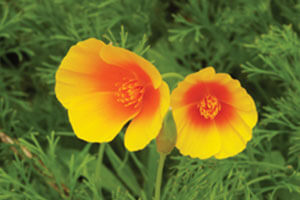
The family Papaveraceae is made up of about 26 genera and 200 species.1 Most are annual or perennial herbs, but the family also contains a relatively few shrubs and small trees, some of which (probably most) come from the warmer parts of the world.
The leaves are placed alternately on their stems and can be either entire or with various indentations around their edge. There are no stipules.2 The plants usually have milky, reddish or orange-colored and thickened sap.
The flowers are showy, radially symmetrical, and contain both male and female parts (complete). The calyx generally has 2 or 3 separate sepals3 but these are united in the genus Eschscholzia (example the California poppy presented here). They often fall quickly when the flower opens and might easiy be missed. There are usually 4 to 6 or 8 to 12 biserrate4, crumpled and overlapping, but separate, petals. There are numerous stamens. The sepals, petals and stamens are inserted on the terminal expanded end of the floral stem (receptacle) and free from the ovary. Thus the ovary is considered to be in the superior position. The ovary consists of at least two, but usually more, united carpels5, which are indicated by the number of stigmas that are fused to the top of the ovary. The carpels are united to form a single chamber and mature into a capsule6 that contains many small seeds.
The family is, depending on your personal perspective, not of major economic importance. It supplies a few ornamentals and Papaver somiferum which contains opium and many of its derivatives including morphine, heroin, and codeine.
References:
Smith, James, Payne. 1977. Vascular plant families. Mad River Press, Inc. Eureka, CA.
California poppy, poppy, eschscholzie de Californie, pavot de Californie
Scientific name: Eschscholzia californica
Origin: According to the USDA Plants Website[13] the species is native to a number of the lower 48 states but has been introduced into much of Canada and Alaska.(See distribution map provided).
Plant description: Eschscholzia californica is a highly variable caulescent7 species. It can be either an annual or a perennial derived from a heavy tap root. It can be either erect or spreading and either glabrous8 or sometimes glaucous. Its stems are generally 5-60 cm (~1.97- 23.6 in).
The leaves can be either obtuse or acute.9 The floral bud is generally erect, acute to long pointed, generally glabrous but sometimes glaucous. The part of the stem to which the flower is attached (receptacle) is in the shape of an inverted cone (widest part on top) and has a spreading rim 0.5-5mm (~0.02-0.2 in). The petals are 20-60 mm (~0.79-2.4 in) and are colored orange and /or yellow with the bases generally orange. The fruits are 3-9 cm (0.1.2-3.5 in). The many brown to black seeds are round to elliptical and 1.5-1.8 mm (~0.06-0.07 in) wide.[4] Because of the great variability in this species, there are indications that more study is needed to determine their taxonomic boundaries. Notice the difference in the two photos provided here.
Distibution: The Jepson Manual[4] indicates in California the plant is found in grassy open areas under 2500m (~8202 ft). The species’ eastern populations are frequently viewed as
PHOTO CAPTION
Eschscholzia californica flowers. Top: Photo taken in the W. J. Beal Botanical Garden on 5/27/2004 in the
‘Unofficial’ Economic Medicinal Plants Collection.


